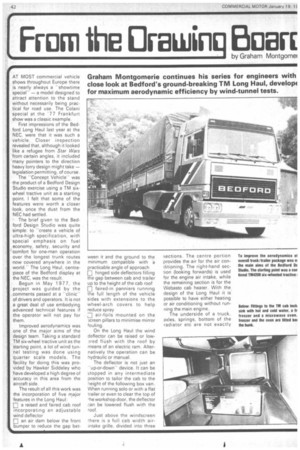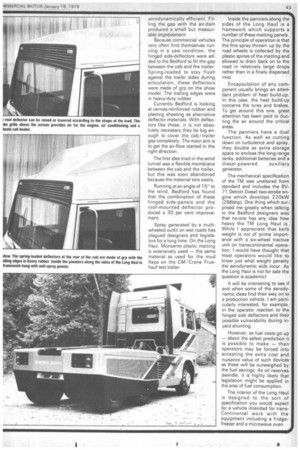( From the Drawing papn Montgomei AT MOST commercial vehicle shows throughout
Page 44

Page 45

If you've noticed an error in this article please click here to report it so we can fix it.
Europe there is nearly always a -showtime special" — a model designed to attract attention to the stand without necessarily being practical for road use. The Colani special at the '77 Frankfurt show was a classic example.
First impressions of the Bedford Long Haul last year at the NEC, were that it was such a vehicle. Closer inspection revealed that, although it looked like a refugee from Star Wars from certain angles, it included many :pointers to the direction heavy lorry design might take — legislation permitting, of course
The "Concept Vehicle" was the product of a Bedford Design Studio exercise using a TM sixwheel tractive unit as a starting point. I felt that some of the features were worth a closer look, once the dust from the NEC had settled, The brief given to the Bedford Design Studio was quite simple: to "create a vehicle of ultra-high specification, with special emphasis on fuel economy, safety, security and comfort for one-man operation over the longest trunk routes now covered anywhere in the world." The Long Haul, centrepiece of the Bedford display at the NEC, was the result.
Begun in May 1977, the project was guided by the comments passed at a "clinic" of drivers and operators. It is not a great deal of use embodying advanced technical features if the operator will not pay for them.
Improved aerodynamics was one of the major aims of the design team. Taking a standard TM six-wheel tractive unit as the starting point, a lot of wind tunnel testing was done using quarter scale models. The facility for doing this was provided by Hawker Siddeley who have developed a high degree of accuracy in this area from the aircraft side.
The result of all this work was the incorporation of five major features in the Long Haul: E a raised and faired cab roof incorporating an adjustable wind deflector E an air dam below the front bumper to reduce the gap bet ween it and the ground to the minimum compatible with a practicable angle of approach [1] hinged side deflectors filling the gap between cab and trailer up to the height of the cab roof E faired-in panniers running the full length of the vehicle sides with extensions to the wheel-arch covers to help reduce spray • air-foils mounted on the 3creen pillars to minimise mirror fouling.
On the Long Haul the wind deflector can be raised or low)red flOsh with the roof by means of an electric ram. Alternatively the operation can be hydraulic or manual.
The deflector is not just an "up-or-downdevice. It can be stopped in any intermediate position to tailor the cab to the height of the following box van. When running solo or with a flat trailer or even to clear the top of 'he workshop door, the deflector can be lowered flush with the roof.
Just above the windscreen there is a full cab width airintake grille, divided into three
sections. The centre portion provides the air for the air conditioning. The right-hand section (looking forwards) is used for the engine air intake, while the remaining section is for the VVebasto cab heater. With the design of the Long Haul it is possible to have either heating or air conditioning without running the main engine.
The underside of a truck, axles, springs, bottom of the radiator etc are not exactly aerodynamically efficient. Filling the gap with the air-dam produced a small but measurable improvement.
Because commercial vehicles very often find themselves running in a yaw condition, the hinged side-deflectors were added to the Bedford to fill the gap between the cab and the trailer. Spring-loaded to stay flush against the trailer sides during articulation, these deflectors were made of grp on the show model. The trailing edges were in heavy-duty rubber_ _ Currently Bedford is looking at canvas-reinforced rubber and plasting sheeting as alternative deflector materials. With deflectors like these, it is not absolutely necessary they be big enough to cover the cab /trailer gap completely. The main aim is to get the air-flow started in the right direction.
The first idea tried in the wind tunnel was a flexible membrane between the cab and the trailer, but this was soon abandoned because the material tore easily.
Running at an angle of 15 to the wind, Bedford has found that the combination of these hinged side-panels and the roof-mounted deflector produced a 30 per cent improvement.
Spray generated by a multiwheeled outfit on wet roads has plagued designers and legislators for a long time. On the Long Haul, Monsanto plastic matting is extensively used — the same material as used for the mud flaps on the CM/Crane Fruehauf test trailer. Inside the panniers along the sides of the Long Haul' is a
framework which supports a number of these matting panels. The principle of operation is that the fine spray thrown up by the road wheels is collected by the plastic spines of the matting and allowed to drain back on to the road in relatively large drops rather than in a finely dispersed. mist.
Encapsulation of any component usually brings an attendant problem of heat build-up. In this case, the heat build-up concerns the tyres and brakes. To get around this one, great attention has been paid to due-. ting the air around the critical areas.
The panniers have a dual function. As well as cutting down on turbulence and spray, they double as extra storage space to enclose the long-range tanks, additional batteries and a diesel-powered auxiliary generator.
The mechanical specification of the TM was unaltered from standard and includes the 8V71 Detroit Diesel two-stroke engine which develops 220kW (296bhp). One thing which surprised me greatly when talking to the Bedford designers was that no-one has any idea how heavy the TM Long Haul is. While I appreciate that kerb weight is not of prime importance with a six-wheel tractive unit on transcontinental operation, I would have thought that • most operators would like to know just what weight penalty the aerodynamic aids incur. As the Long Haul is not for sale the question is academic!
It will be interesting to see if and when some of the aerodynamic ideas find their way on to a production vehicle. i am particularly interested, for example, in the operator reaction to the hinged side deflectors and their possible vulnerability during inyard shunting.
However, as fuel costs go up — about the safest prediction it is possible to make — then operators may be forced into accepting the extra cost and nuisance value of such devices• as these will be outweighed by the fuel savings. As oil reserves dwindle, it is highly likely that legislation might be applied in the area of fuel consumption.
The interior of the Long Haul is designed to the sort of specification you would expect for a vehicle intended for transContinental work with the equipment including a fridge.. freezer and a microwave oven.




































































































